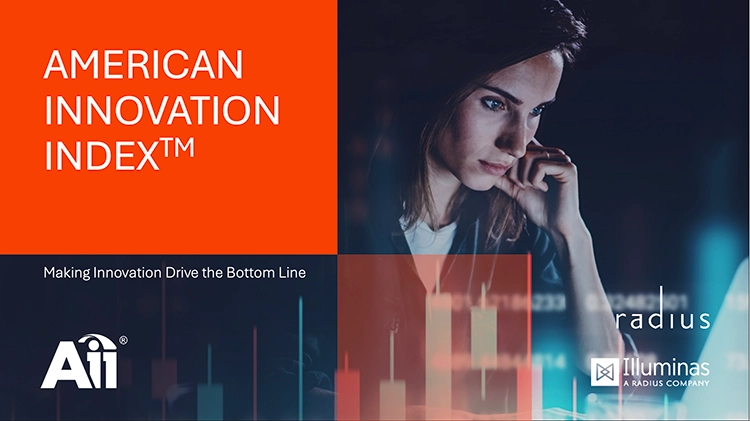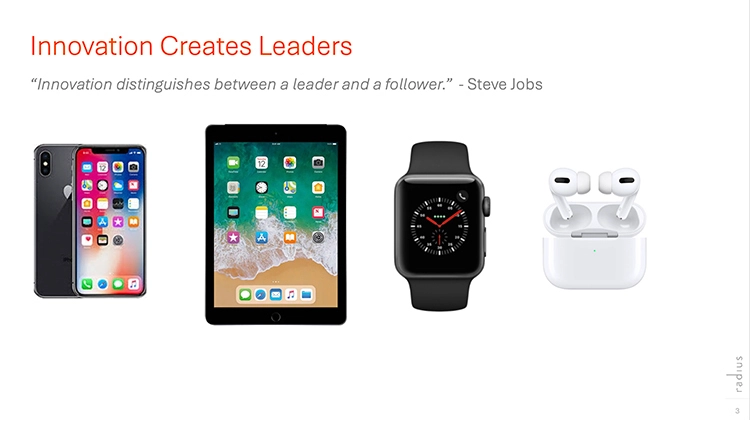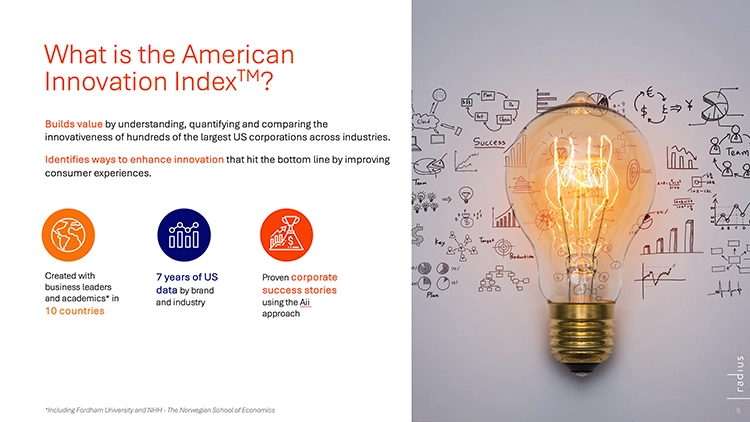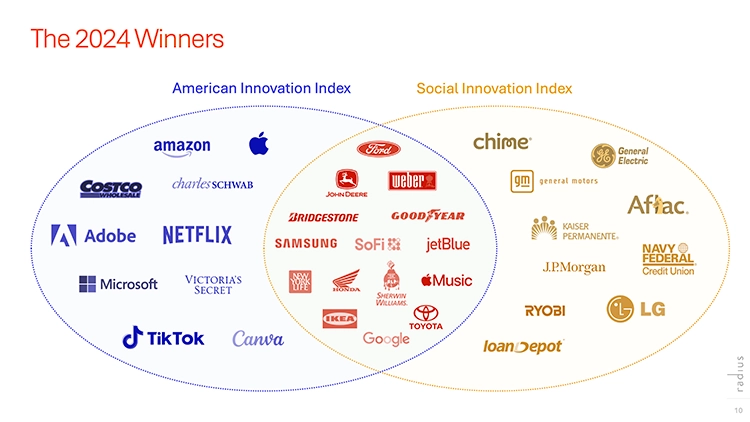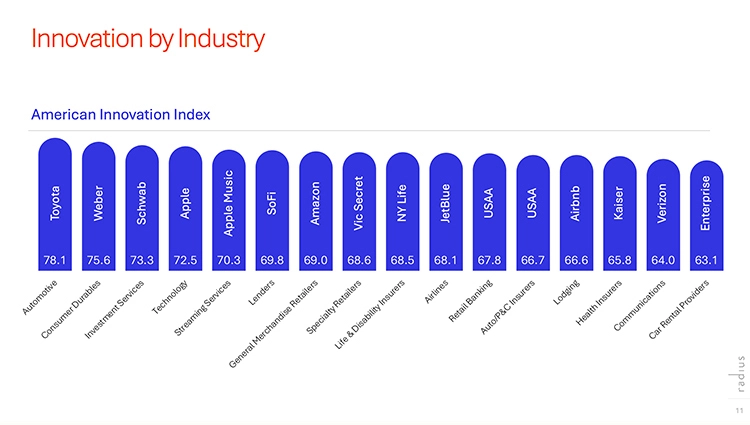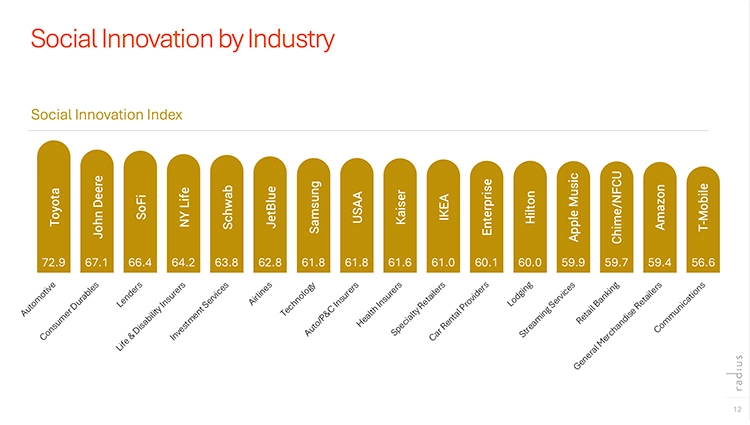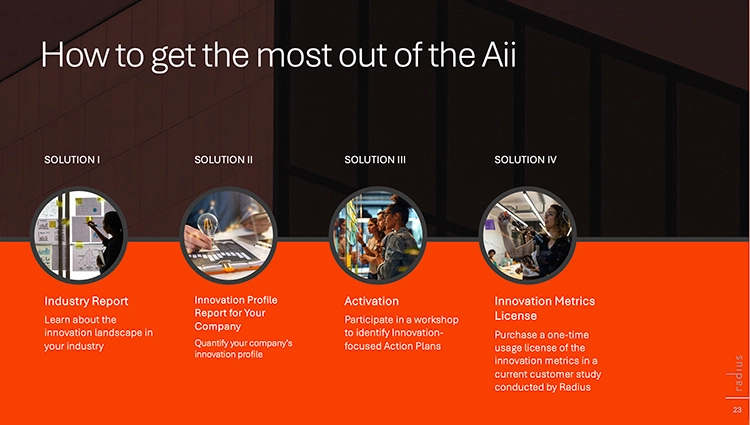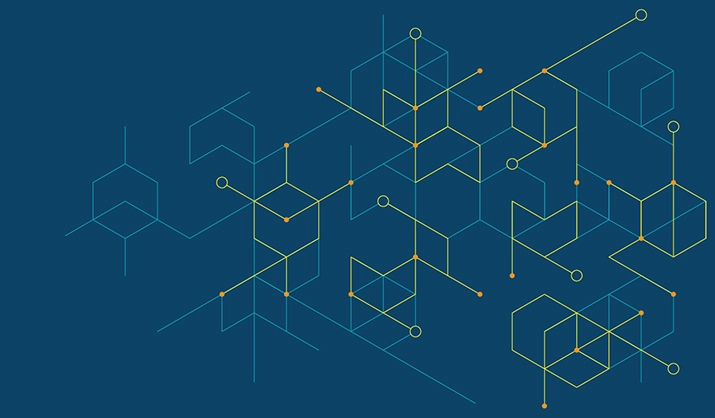In this American Innovation Index webinar, leaders from Radius, Illuminas, and Fordham University’s Responsible Business Center explore how customer-perceived innovation drives brand loyalty, financial performance, and social impact. You’ll hear real-world examples from top performers in the Aii rankings—including Apple, Toyota, Amazon, and Navy Federal Credit Union—and learn how brands in any industry can build innovation perceptions that influence the bottom line. Watch the full video or read the edited transcript below.
Take a look at a few key slides from the presentation:
Read the webinar transcript below:
Paul Donagher:
Hi everybody. My name is Paul Donagher, and I’m responsible for client services here at Radius. And thanks to all of you for attending today’s webinar. It’ll be on the American Innovation Index, and we’ll be finding out how innovation helps drive the bottom line. The webinar today will be presented by Gina Woodall, who’s a VP and Group Director at Illuminas—Illuminas is a Radius company–and Leigh Anne Statuto, executive director of the Responsible Business Center at the Gabelli School of Business at Fordham University.
Thanks so much to both Gina and Leigh Anne for doing the webinar today. As with all our webinars, we’re scheduled to start right now and run for about 45 minutes. And if you would like to ask a question, please type one on the screen, I see those as we go. And at the end, I will collect the questions we’ve got and pose those to Gina and Leigh Anne. They will speak for about 30 minutes, so hopefully we’ll have 5 to 10 minutes at the end for questions.
So, by way of introduction, and during today’s webinar, hopefully you’ll come away with enhanced understanding of a number of things, but most critically, three elements that I’d like to call out: trends in innovation and social innovation perceptions that have occurred in the U.S. over the past seven or eight years; best practices that make innovation programs stand out; and tools and metrics that will help you prioritize your activation strategy and build innovation perceptions.
And this is all about consumer-led perception, so hopefully you’ll find out something useful for your organization there. And so, an introduction to today’s two speakers.
Gina is, as I said, a Vice President and Group Director with us here. Gina is passionate about finding the right solutions for clients in many sectors–notably services, tech, nonprofit and others. She’s been involved with the Aii since the beginning, and prior to joining Illuminas and Radius, Gina was president of Rockbridge Associates. Gina lives in the DC area and loves to hike, kayak, and visit national parks with her family.
Leigh Anne began her career in the nonprofit center supporting homelessness prevention efforts in New York City, before transitioning to sustainably focused work. She’s been with the Responsible Business Center at Fordham, as I mentioned, for the last three and a half years, and the role of Executive Director for the last two years, where she works closely with all the corporate partners that they have in the business school.
She advances sustainably linked initiatives, and guides the organization’s strategic development and thought leadership. Leigh Anne is an avid reader, and lives in Astoria, Queens with her husband. And with that brief introduction, I believe Leigh Anne is going to kick us off. So, Leigh Anne, over to you.
Leigh Anne Statuto:
Thanks so much, Paul. Pleasure to be here. So we’re going to kick it off thinking about innovation, right? Often when we think about innovation, Apple is one of the companies that comes to mind. They really think of what a seamless ecosystem is for a customer, and I think that’s part of the reason they’ve really come forward. So take, for example, the iPhone.
They’ve really revolutionized what the smartphone industry looks like. Then came the iPad, then came the Apple Watch, then the AirPods, and then they seamlessly linked them all together with the iCloud and the App Store and so many other things. They didn’t just create a new product, but they really created a holistic experience that keeps users engaged.
While we believe Apple’s innovation is about cutting-edge technology, it’s also about thinking about the customer. And when we start to think about that, we think, well, is innovation only linked to the technology industry? And I hope from today’s webinar you’ll take away that the answer is no. You can really bring innovation in so many different industries. For example, here you’ll see our top 10 from the 2024 American Innovation Index, and Apple’s on top, so we’ll give them credit for that.
But when you go down, you see automotive industries really leading the way. A lot of that comes from the electric vehicle industry that’s really been pioneered. You see Amazon, you see John Deere, perhaps maybe not the companies you’d see at the top, but it really shows that across different industries you can have customer-perceived innovation at the top where you’re really driving the bottom line as well.
So, I think today we’ll really talk a lot about why companies should strive to be innovative, and no matter what business or industry you’re in, what it really means to be innovative within that industry. Innovation, in my view, is really thinking differently, putting customers at the forefront. And Gina, can you explain a little bit more about what the American Innovation Index is?
Gina Woodall:
Absolutely. So, the American Innovation Index, or the Aii, as we call it, is really a program of research that is designed to understand, quantify, and compare innovativeness of U.S. brands across industries to identify ways to guide innovation efforts and firm growth. The innovation index that we’re going to talk about today originated in Norway, believe it or not.
The researchers at the Norwegian School of Economics believe that the true indicator of innovativeness in a market is what can be gleaned from their own customers and their experiences, rather than industry analysts and experts.
In 2018, we partnered with the Gabelli School of Business Responsible Business Center–Leigh Anne and her team–and the Norwegian school to implement the study in the United States to measure customer-perceived innovativeness of nearly 200 consumer brands across 20 sectors.
And we’re now in our eighth year of the study in the U.S. And since then, the innovation index coalition of business leaders and academic partners have grown to over 10 countries. We now are across Europe, North America, Asia, and Australia, all using the same metrics and furthering the learning around innovation.
So why is customer-perceived innovation important? What our research with our partners has really discovered is that when a company innovates and it has an impact on the customer experience, in terms of the types of products and services offered, changes in the value that’s delivered, how they’re treated as a customer, how they interact–when those things happen and they notice those changes, it elicits positive emotions.
So, we see them feel excited and pleased that they’re doing business with this company, and that leads to brand attractiveness, and ultimately, we’ve proven links to customer loyalty. So, how does it directly impact these key metrics? We took a look at the companies in our index–and there’s over 200 brands in the index–and we’ve broken them up by the least innovative companies, to the moderate, to the most innovative companies.
And we took a look at our bottom-line metrics, and we can see that our loyalty index increases 8 points–8 percentage points–from the least innovative to the most innovative companies. We see the same thing: Brand attractiveness is higher among those most innovative companies, the NPS scores, and ultimately their share of business. And not only share of business, we wanted to go a little bit deeper.
So, we took the first five years of index data–and we hold the financial returns for the brands in our study–and did an analysis to see what the impact is on the financial bottom line. And we found that innovation increases shareholder wealth by an average of 8% across the brands in our study. That’s $3 billion for every five-point increase in our customer innovation index in 12 months.
And that research is published now, it’s peer-reviewed in the Journal of Service Research, if you want to take a look. And I also want to mention that we’re not only seeing this with customers, but we’re seeing it with non-customers as well. We’re now studying innovation’s impact on prospects, and have found that innovation perceptions, if they’re aware of the brand at least, will drive conversion among those non-users.
So, a brand’s perceived innovativeness in a market can have a major impact on its success in converting prospects to users. Consumers like to work with innovative companies. So how does the study work? This is an online survey that we do yearly. It’s done with over 5,000 U.S. adults across 20,000 customer touch points.
That means that each customer’s rating up to five brands that they do business with on the key metrics in our study, which are innovation, social innovation, customer loyalty, and brand attractiveness. The American Innovation Index, that I’m going to talk a lot about, is the degree to which customers view a brand as innovative, creative, pioneering and changing the marketplace.
Social innovation we define as the degree to which customers view a brand as innovating on behalf of society and the environment. Last year we included 13 industries, and these industries were chosen to be in the study because they’re the top consumer-driven sectors in the U.S. economy. So that’s why we focused on them, they are all consumer-driven, not B2B.
And the companies or brands that we included within each of these industries were the largest U.S. companies–Fortune 200, typically–but we also did include some market leaders. If they were more disruptors and weren’t reaching the Fortune 200, we still wanted to include them to have a complete picture of the industry.
So, let’s take a look at some of the findings. And this is just some trend lines on each of the indexes over the past seven years of this study. I will say we are in data collection right now for 2025, so we’ll have those results soon. But what we see on the blue line is the American Innovation Index.
For 2024, our average score across all our brands was a 69.2, and that is on a 0-to-100 index scale. And that ranges from a low of 53 for Motel 6 all the way to a high of Apple, which is at an 84 on our index. The social innovation index last year was a 61.6, which ranged from a low of 48 for X/Twitter to a high of 79 for Toyota.
And then taking a look at this trend line and what all this means, what we saw is that in 2020, 2021–I’m sure you don’t remember what happened then–but the pandemic was going on, really challenging businesses, and what we saw was a surge in innovation, right? They had to adapt their business models, think about things differently. And that was driven down to the customer, right?
How do we interact with customers and make a positive experience to continue to grow? We saw that surge in innovation, now we’re seeing it level off, which means there’s a real opportunity for brands to differentiate based on customer-perceived innovation, while other companies might be getting a little comfortable and not innovating as quickly as they have in the past.
Each year we award the top 25 companies that score the highest on our innovation index at our innovation conference with Leigh Anne at Fordham in November. And this shows you our top 25 on the innovation index and the social innovation index. In the middle are 15 companies that are in the top 25 for both indexes.
So, you’ll see, we truly believe these are transformative companies. They’re able to excel in both areas. Just to let you know, the top 3 on the Aii, as Leigh Anne mentioned, were Apple, Toyota, and Honda. On the social innovation index, it was Toyota, Honda and John Deere. So, there’s a few lessons as you kind of look through these brands.
The first is what Leigh Anne talked about early on, which is that you don’t have to be a tech firm like Apple and Microsoft on this list to be perceived as innovative by your customers. Our list includes retailers like Costco and Victoria’s Secret as winners, consumer durables like Weber Grills and G.E., and then services firms as well.
We’ve got Charles Schwab, we’ve got Kaiser Permanente, a whole range of companies. And your innovativeness is not predetermined by your industry. Some of these top 25 winners, like Aflac and Chime, are in industries that are in our bottom half of industries in terms of their innovativeness.
So, if that’s not your path, you still can work on innovation and rise to the top. The conference that I mentioned is really designed to share and learn how brands drive innovation efforts in their own businesses. And we’ve heard a lot of great stories over the years. Leigh Anne, can you tell us some of the notable learnings and approaches that we’ve heard from our winners in the conference?
Leigh Anne:
Absolutely, and I’ll just add that the conference is great because we have a lot of the data, and when you actually bring everyone into the room, they tell the story. It brings this data to life. And you’re able to say, “Oh, this is what they’re doing behind the scenes that maybe we don’t know about.”, or “This is what they’re marketing that is really driving their customers to see this more”.
I’ll start on the right-hand side on the social innovation index. A winner that often comes to our conference is Navy Federal Credit Union. They are incredible. And they often talk about the fact that social innovation is really about connection and being a part of a community. If you’re ever to look at their different marketing and things of that nature, you really start to see that community is a big piece of who they are.
And their CMO, who spoke on a panel, literally said that’s how they’re defining their social innovation, of how they are differentiating in the banking and financial area to really say, “we do care about our customers, and we’re bringing them to the forefront”. Because they’re also a nonprofit, they reinvest most of their profits back into the operations, which then translates very easily to their customers through reduced fees, different perks and things like that.
That really emphasizes the societal impact that they can have. Flip-flopping over to Amazon, of course they’re on the American Innovation Index, I think almost everyone here has probably had an experience with Amazon. One of the great stories was talking about how they think about innovation through their press release format.
So, they obviously exemplify what customer-centric innovation really is. They put the customer at the pinpoint that you can get your product tomorrow. And a couple years ago, they were starting to think about their drone technologies, and how they are going to exemplify this and share this with their customer base.
What they do, a really innovative idea, is they write their press release years before it’s ready. They’re like, “We want to have drone technology, let’s write the press release now even though it’s not ready, and we don’t have everything put together yet”. But when they started doing this, they said, “Actually, our customers don’t care about the technology, about the drone. They want to know that we can get an order within 30 minutes of placing that order”.
And so that made them reframe how they were going to move forward with this initiative to, again, put customers at the center. I’m not sure if you’re seeing a theme, but customers at the center is a really big piece of the puzzle. And then we’ll come to IKEA. IKEA’s here in the center, they’re wonderful.
We had a fireside chat with their head of sustainability in the U.S. last year, and they’re doing a lot of different work both on the societal impact as well as the environmental impact. IKEA, as we all know, really is a way to democratize design in your home so everyone can have a nice home that’s at an affordable rate. Two really cool examples that they shared of how, when we said, “What’s social innovation mean to you, what are things you are doing?”
They said they’re working in a trauma-informed design in Texas, looking to create spaces within the home that when someone comes home that may have some sort of trauma, they feel safe at home. How did they do this? They met with psychiatrists, they met with architects, with interior designers, with customers, and they brought all of them together to have a really trauma-informed design.
The other aspect is the circular economy of having continuous products within a cycle so that you’re not throwing things away–great for the environment, really about that at the Responsible Business Center–but they bring their customers into it, right? They have a buyback program that they’re able to have their customers sell back their old shelves, and then someone else can buy that at a reduced cost.
Again, really democratizing it so people can afford it at different rates, but also making sure that you’re not just throwing things away. The big piece of this puzzle is really understanding “How are we bringing the customer into the equation? How are we marketing that to the customers, so they know this exists?” And again, all three of these companies are doing such great jobs, but the ones in the center are doing both and they’re exemplifying it in many ways.
So, Gina, I’ve done some anecdotal examples from the conference, but can you share more on how the different industries rank across these indices?
Gina:
Absolutely. Let’s look at the innovation index by industry. And you can see, I know a lot of you, you’re from all different industries, so you’re probably very curious how the industry’s coming out. What we see is, when you look at it by industry–and you see automotive is our number one industry, and Toyota is our leader of that industry, followed by consumer durables and then investment services with Schwab, leading that industry.
And then you get to technology. I find that interesting. You may have thought technology would be first and foremost in terms of our industry list, but they’re fourth on innovation. And just to kind of give you the perspective from the other end, we see some services businesses like car rental providers; communications, which includes cable, ISPs and wireless companies; as well as health insurers at the bottom.
You can see the difference at the different levels. We also dug in–of course it’s great to see the rankings, but it’s kind of like, “Why are they at the top and they’re at the bottom?” So we looked at the data to understand just that: Why is that? Where do we see big differences between winners and non-winners? And the number one thing that we see, the biggest gap between winners and non-winners, is around having exceptional products and services.
It really does come down to the products and services in many cases. Also having a wide range of products to offer and continually introducing products. That’s something that’s particularly important to the technology industry. Another interesting one that’s kind of close to the top is incorporating stylish and interesting design in products and services.
And that’s important for tech companies and lodging companies in particular. So we just found that very interesting. But those are some of the things that we see driving it. And of course there’s a lot more detail, but overall, when you look across industries, that’s what we see.
When we look at social innovation, you can see that many of the industries that I just talked about that were high on innovation are also high on social innovation, particularly automotive and consumer durables. I think it’s interesting, but not surprising, that we see tech has moved down a little bit further in terms of social innovation. And you see streaming services, as well as general merchandise retailers, moving much further down.
It’s important–a company like Amazon that we just exemplified here–they’re number 6 on innovation, but they’re number 39 on social innovation. It’s important for brands to think not only about innovation, but also about social innovation, if they want to be truly, what we call transformative, and get the benefit of increased loyalty by being strong in both.
Leigh Anne, I know we’ve been working on this book on customer-perceived innovation, and you’ve been writing the social innovation chapter, and you’ve used the banking industry as your example. And we see banking kind of struggles; it’s third from the bottom here with Chime and Navy Federal leading that sector. But can you tell us a little bit about what you’ve seen about these winners and how the banking industry can really shine in social innovation?
Leigh Anne:
Yes, absolutely. As we dug into this a little bit more, we looked at some of the more qualitative data of customers really saying, why do they view this as socially innovative? So, we looked at the top winners–so Chime is a great example, here–and the key things that came across from this.
First is exceptional customer support–which honestly may feel like an innovation piece–but because you’re dealing with someone’s bank account, this is really important and you’re looking at the societal impact of that. The other aspect was local community impact. So, how are they engaging in your local area? Are you sponsoring a soccer game, or are you showing up for employee volunteerism?
And then environmental responsibility was another piece. Less so, but there’s a lot of things like, do you want to recycle your card? Do you want to recycle all this paper? Do you want to go paperless? That was another piece, but across the biggest concept was trustworthiness. And while that is innovative, it’s socially innovative, of “Can I trust you with this?” So, that’s like table stakes. You need to really convey your trustworthiness as a retail bank.
But as we started to look at this a little bit more, the two banks that really stuck out were Chime and Fifth Third Bank. Chime is really focused on the unbanked. And so, they do many different innovative initiatives and technologies, one that’s called spot loans, and this provides short-term relief to anyone that might be facing an immediate expense and just needs a quick loan that they can repay back shortly.
They also spend a lot of time for financial literacy, which is important to their communities that they serve. One other piece that got mentioned here was the fact that they were able to balance AI technologies–when you call on the phone and you need someone to help–with a real-life support system. So, you were getting the support you needed through innovation and through AI, but also balancing it to make sure your needs were met.
Fifth Third Bank was another example, really looking at that local community impact. They have a lot of employee volunteerism. They show up in the communities that they’re in and their customers recognize this, which was an important piece of the puzzle. So, I spoke a little bit about the banking side, but Gina, can you talk a little bit more about another industry, perhaps lodging?
Gina:
Absolutely. I want to share with you next a case study, so you can kind of see how some of this analysis that we’re doing works. And we’re going to take the lodging industry just because it’s very familiar to everyone, and you can understand thinking through what innovation means in this industry. But let’s start first with how the brands fall out in lodging. We have Airbnb at the top here. The blue bar is the American Innovation Index. They are the winner in the industry.
Probably not too surprising to you, maybe you don’t even consider Airbnb a part of the lodging industry. But in fact, I think all these traditional hoteliers would in fact say, “Yes, they are competing with us.” So, they are number one on innovation. But you see social innovation is led by Hilton, followed by Hyatt.
So, the more traditional brands do better on social innovation. How do these more traditional brands get closer to Airbnb on innovation? I’m going to show you a traditional brand. I won’t tell you who it is, but let’s look at a traditional brand and how they can identify what to do to improve their innovation rankings. And this is part of the analysis that we do.
We ask customers how well these 18 potential areas that could drive innovation describe the brand. We correlate it with our indices, both the innovation index as well as our loyalty index, to really show the impact on innovation and loyalty. So, the higher up you are on this graph, the more that attribute drives innovation. The more to the right, it drives loyalty.
And then when you put them together, you go along the diagonal line, the further out you are on differentiating power, those are areas that really drive innovation and loyalty. That’s our sweet spot, those differentiators. This is where there’s real impact on innovation. It’s just interesting to see what pops in for a lodging brand. All the way on the right you see stylish and interesting products and services.
You think about some of these traditional hotel chains, they’ve got a number of different brands that fit every traveler, occasion, lifestyle, and then lots of interesting decor on the insides of their properties. That really plays into differentiating them and making customers feel they’re innovative.
Similar to fast and responsive customer service there at the top, things like using an app to open your room and bypassing the front desk, that’s something that is very innovative and seen by the customers as thinking about their innovation perceptions. We also identify disruptors. We define disruptors as things that drive innovation in the long run.
They don’t drive loyalty right now, customers don’t recognize them as much, but in the long term, they do drive innovation perceptions, and we need to think about those. After we look at what drives innovation, we can look at how well the brand performs on the drivers. This is the percentage of customers who feel that each of these describes the brand very well.
And we’ve color coded them based on differentiators, disruptors, and table stakes, so they can kind of see where they stand right now. And then we can take this data for how well they perform, and take the drivers, and we can come up with priorities for them for leveraging innovation. So, they have equities, areas that have a high impact on innovation, but they’re doing well on them, so they should maintain their commitment to them.
But then the opportunities are areas where they have a high impact, but there’s a lot of room for improvement. That’s innovation. That’s how you can identify the ways that you can drive your innovation strategy. I want to quickly go to social innovation, but social innovation is a little more nuanced. Leigh Anne, can you tell us a little bit about how brands should think about approaching social innovation?
Leigh Anne:
Yes, so this kind of comes back to our banking example as well. The most basic form of social innovation is usually improving the wellbeing of the customer. So that’s that centric circle there. It’s what people see, it’s what’s most tangible to them and how closely that social area relates to their own experience and to their community. The ones that are maybe not most realized are things loftier.
So, thinking about the environmental goals. While there’s a lot going on in the space, it’s not exactly where you may want to focus when you’re trying to get people to see about the social innovation piece. Thinking more about the banking side for a moment when we’re saying, “Do you want to recycle this paper?” that brings it a little more closely to a customer, because you feel like you can make an impact.
But the overall benefit is really the world beyond, which is a lot less tangible for customers to get. And when we start to think about this, if I would encourage companies to think about how can we make this feel like it’s a little more selfish, right? How does the customer see it? How does it impact their children? How does it impact their families? How does it impact their community?
Once you really got that going, I think then you can move on to something that’s a little bit more broad. Not saying you shouldn’t do the broad things, but you’re really trying to drive the social innovation piece. It comes from the customer piece first. Can you share this concept in the lodging aspect, Gina?
Gina:
Yes. Looking at a very similar analysis on the social innovation side, here we have 15 attributes that have the potential to drive social innovation, and again, our disruptors. And what we see–I find this interesting–all the way at the top, the attribute that most drives innovation is “fosters education, learning. and exchange of ideas”. You think about this in terms of a hotel brand, what could this mean?
You think about when you walk into a hotel, and into your room. Think about a lot of the signage that you see around, for example, “If you hang up your towels, we won’t wash them every day”, saves on water, notes about recycling, sustainability–different ways that the property is maybe supporting those elements of social innovation. And that’s really educating the customer, right?
These are things that I can do. And back to Leigh Anne’s diagram on the last slide, this is kind of our second layer of social innovation, the co-creation, you’re working with the customer, like “Customer, here’s a way you can recycle. I’m telling you about it, I’m giving you a bin. But it’s your job to recycle.” We’re working together to further social innovation in the environment. These are some of the drivers that you can see.
And similarly, we can look at the performance on them. You can see performance is not nearly as high as it is on innovation for this lodging brand. And then we can again, look at our priorities. So similar analysis, I won’t spend too much time because I know we’re running close on time. But just to kind of sum up everything, what we see is there’s five steps to winning on innovation.
First step is measure where you stand, start with a baseline. How do you fare on the innovation index and social innovation index? And then compare that to your customers. How do you look against them? And then do an internal resource assessment. Assess what your innovation assets are that you can bring forward to your customers that could affect their perceptions of innovativeness and social innovativeness but also look at the root causes.
We talk a lot at our conference–the winners do–talk about the culture of innovation within their organizations. And that’s something that you can think about as you go through this assessment. And then set your strategy and your goals. Do an analysis like this where you can look at what’s really driving innovation perceptions and where can I focus and then track it over time.
We have several financial institutions right now that have been doing this for the past three years. They’ve been watching their scores and looking at what’s impacting them, working in those areas, and they’ve seen their scores go up in an area where, as we talked about, retail banking is not always seen as particularly innovative or socially innovative. If you’re interested in improving or assessing your perceptions of your brand, this is a good way to do it.
And then finally, you can talk to us at Radius and Illuminas. We have four solutions to inform your innovation journey. We do have industry reports from this data with the eight years of data that we have to really learn about the industry in terms of which brands lead, which ones are winning and why, and what the strategic priorities are for the industry.
Solution two is more custom. It is an innovation profile report for your company. You can see what your scores are, your competitors, your priorities specific to you. If you’re not currently in the study, that’s okay. We can work around that. We have a solution for that. The third solution is activation, doing a workshop to help you get focused and develop an action plan from the data that we’re seeing.
And then finally, another idea is to be able to use the innovation metrics. If you’re currently doing a study with us, we can put the indexes in your study. It’s four questions for the innovation index, and three questions for the social innovation index. So, you can at least see how you measure and then we can compare it to competitors that we have.
We have a lot of brands that feel like they need to strengthen innovation, they feel like it’s an issue for them, and these solutions can help. But we also have brands that are doing well on innovation, and what they’re more concerned about is “Can you help us prioritize where we should focus to get the biggest impact?” So, either way.
Alright, so that is all Leigh Anne and I have for you today. We really thank you for listening and want to make one big plug for the American Innovation Conference that is November 19th this year at Fordham. As you can tell, we get a lot of great speakers and have terrific stories for everyone to hear. And I think everyone learns a lot from it. So, I’d love for you to join us. Thank you!
Paul:
Gina, Leigh Anne, thank you. We’ve got a number of questions, folks, and I’ll get to as many of them as I can. I’ll double-plug the conference on November 19th, definitely something to put in your calendars. So, the first one is around how we define innovative or innovation for people who take the survey. In the survey itself, do we give a definition? Do we leave it up to the individuals in terms of interpretation? How do we handle that in the survey itself?
Gina:
Leigh Anne, if you want me to answer, I’ll jump in on that one. <Laugh>. The way we measure innovation–social innovation–the metrics were developed with our academic partners in Norway, as well as Fordham and us. And we did a lot of initial research and got a lot of open-ended data as well. The metrics were designed, and then they were validated.
We have four key questions for innovation and three for social innovation that we have proven have linked to loyalty, and have really been through the rigor, I would say, to define customer-perceived innovation and social innovation.
Paul:
Got it. That’s very helpful. Second one someone asked us–and I’m going to kind of merge this into two separate questions that we got here. There are different sectors, you guys mentioned a couple of different sectors there. What are the sectors that you include?
Gina:
I’m sorry, what were the sectors…?
Paul:
You guys mentioned a couple of sectors, you mentioned lodging, I think. Leigh Anne, you mentioned a couple, too. What are the sectors that are covered in the study?
Gina:
Yes, there’s 13 sectors. Let me go back to that. So again, they’re the largest consumer driven sectors. We’re covering insurance, automotive, banking and lending, communications, consumer durables–which include manufacturers, car rental providers, retailers–both general merchandise as well as some specialty retailers, investments, life and disability insurance, lodging and technology.
Those are the ones that we cover now. We do have some data for some other industries from the past as well, but they are focused on consumer driven industries. B2B is something that we are exploring now. If you’re a B2B company and interested in something like this, reach out. Our coalition is working on a methodology, and we can give you an update on that as well.
I also want to let you know if you are a credit union, we also do a separate study with the Filene Research Institute, where credit unions can participate and it’s more tailored to them, using the same metrics so we can benchmark against banks. And we are launching this month one for associations and nonprofits. If you’re in that sector, we’re working with ASAE and partnership and we’re going to launch that one as well.
Paul:
That’s a good segue. I have a question here from, I can see, Leslie–Leslie, I don’t see your last name, I’m sorry. You kind of touched on it. Gina, is there a separate Aii for B2B? So, you were saying, what is the right process here? What is the process, as you can see, testing from here for B2B?
Gina:
Right, you can imagine B2B is more challenging due to the sampling. That is something that we’re working on now within Radius and with our academic coalition partners. We’ve done some initial testing of different approaches, and now we’re working on trying to move that forward.
If you’re interested, I would encourage you to reach out to your contact at Radius or Illuminas, or you can reach out to me, and I will get you in touch and with those that are working on that initiative, if you’d like to get involved or just hear more about what we’re doing.
Paul:
Got it. I have one more question here, guys. Keep typing them in. We’ve got three or four more minutes that we can keep the line open for. Are satisfaction and innovation, do they measure the same thing? Are they the same thing and do they measure the same thing? Do you guys have a point of view on that?
Gina:
Yes, so that’s the question we get quite a bit. Satisfaction and innovation, while they are correlated, they don’t track perfectly. Satisfaction, if you think about that metric, it really had the positive and a negative, right? Highly satisfied to highly dissatisfied. Whereas innovation really does not, particularly in the way we measure it.
Our questions are designed to objectively measure, “Do you as a customer notice changes in the business in different ways?” So, it’s more objective, and innovation is not always a positive thing. Some people just want things to stay the same, right? They are different metrics and, again, correlate but don’t track perfectly with each other.
Paul:
Got it. Those are the questions that we have. Thanks everybody for your attendance today. Our next quarterly webinar will be Q3. We’ll be sending out invites for that in September. All that remains for me–Leigh Anne and Gina, thank you so much for this presentation today and we’ll see you all soon. Thank you.
Learn more about the American Innovation Index
The American Innovation Index webinar highlights the insights from an eight-year study measuring how U.S. consumers perceive brand innovation and social impact. Conducted in partnership with Fordham University and the Norwegian School of Economics, this research provides powerful guidance for companies looking to prioritize innovation in ways that customers notice—and value.
Want to assess your brand’s innovation performance?


